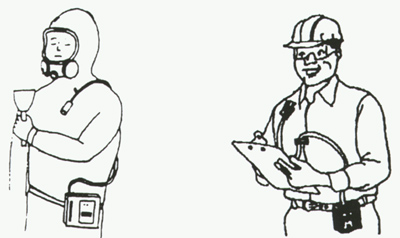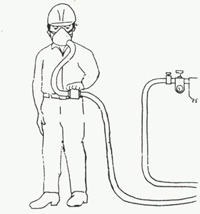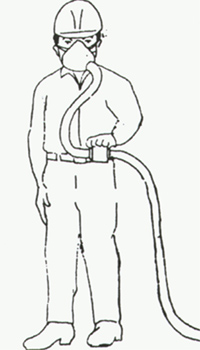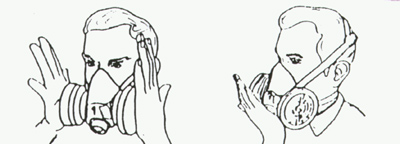Summary Statement
A guide for construction workers, and contractors who work on bridge rehabilitation jobs, describing lead controls and contractor responsibilities to provide a safe working environment.
1998

TABLE OF CONTENTS
CHECKLIST: EMPLOYER DUTIES
EXPOSURE ASSESSMENT
ENGINEERING & WORK PRACTICE CONTROLS
INTERIM CONTROLS
PROTECTIVE EQUIPMENT & HYGIENE FACILITIES
FIT TESTING
CHECKLIST: WORKER RESPONSIBILITIES
The Construction Hygiene and Ergonomics Program provides programs in worker protection and regulatory compliance for companies, agencies and unions involved with rehabilitation, repair, and modification of steel structures and buildings coated with lead-based paint. It offers full medical surveillance and blood lead testing; exposure assessment and air monitoring; and training services. In cooperation with the Hunter College Industrial Hygiene Program, Mount Sinai also researches workplace exposures and evaluates state-of-the-art engineering and work practice controls on construction sites.
"Working with Lead on Bridges" is a publication of the Mount Sinai-Irving J. Selikoff Construction Hygiene and Ergonomics Program (formerly Lead in Construction Program). It is a guide for ironworkers, laborers, painters, other construction workers, and contractors who work on bridge rehabilitation jobs. It describes contractor responsibilities to provide a safe working environment and to implement lead controls. Contractors should have a copy of the OSHA standard, 29 CFR 1926.62, Lead Exposure in Construction, on hand for a more detailed description. This guide also reminds workers of their responsibilities to comply with company safety programs and to participate in lead control programs.
Lead is a poisonous metal. It has been used in paint for hundreds of years. Since lead-based paint inhibits rusting and corrosion on iron and steel, it has been used on bridges and other steel structures. It is estimated that more than 90,000 bridges - many in need of repairs - in the United States are coated with lead paint. Lead dust and fumes are released into the air whenever lead paint is disturbed during maintenance, reconstruction, and demolition of bridges and other steel structures.
Lead was banned from residential paints in 1978 by the federal government, but it is still allowed in industrial, marine, and bridge paint. Fortunately, many owners no longer use lead paint on bridges and other structures.
- torch cutting, burning
- welding
- abrasive blasting
- grinding
- piston scaling
- rivet busting
- needle gunning
- scraping
- chemical stripping
- sweeping, cleaning up
Workers, and others nearby, are exposed when they perform these tasks. Burning is especially hazardous because lead boils at about 3000°F. An oxyacetylene torch, which burns between 5400° and 6400°F, easily vaporizes all of the lead it contacts forming tiny fume particles. The smaller the lead particle, the easier it makes its way to the lungs and to the bloodstream.

Lead is hazardous
when it gets into the bloodstream where it can move around the body. High
exposures over a short period of time or lower exposures spread out over
longer time periods can cause lead poisoning. Lead can damage the brain
and nervous system, kidneys, and reproductive systems. Lead also contributes
to high blood pressure. Most of the absorbed lead is eventually stored
in the bones where it may stay for decades. Under certain conditions,
the lead stored in the bone may leach slowly into the bloodstream.
The early effects of lead poisoning are not specific and resemble the
symptoms of a flu. Short term and long term effects of lead overexposure
are listed below.
Lead poisoning is preventable. Many of the health problems caused by lead exposure are reversible if exposure is eliminated or reduced.
SHORT TERM EFFECTS
- stomach cramps
- poor appetite
- irritability/anxiety
- fatigue
- muscle or joint pain
- weakness
- headache
- numbness
- constipation
- sleep problems
- impotence
- loss of sex drive
LONG TERM EFFECTS
- high blood pressure
- nerve disorders
- brain damage
- kidney damage
- reproductive damage
- birth defects

FAMILY EXPOSURES
Construction workers can expose their families to lead by bringing home lead dust on their work clothes, tools, and skin. It is very important to leave all contaminated articles at the job and to shower or wash up before going home. Children and pregnant women are especially at risk. Lead poisoning in children can cause brain damage, mental deficits, behavior problems, and growth retardation.

OSHA inspectors visit construction sites when the agency believes that workers may be overexposed. They routinely investigate bridge rehabilitation sites where lead paint is being disturbed. The agency may be notified about lead hazards by local health departments or workers at the site.
|
Check
Mark
|
|
| Implement written compliance program describing roles and responsibilities, competent person, engineering and work practice controls, recordkeeping | |
| Provide air monitoring, notify workers of results | |
| Set up hygiene facilities: change areas, clean eating areas, showers, and hand washing stations | |
| Use HEPA vacuums or wet methods for cleaning | |
| Post lead warning signs: No eating or smoking | |
| Provide respirators, fit testing, medical evaluations | |
| Inspect, clean, maintain, and store respirators properly | |
| Provide protective clothing and other equipment | |
| Provide blood lead tests within 2 days of exposure and repeat monthly (recommended); OSHA requires repeat tests every 2 months. | |
| Train workers about lead hazards, controls, respirators | |
| Make daily inspections by competent person; keep logs | |
| Provide medical exams: if blood lead level is above 40 mcg/dl; or symptoms are reported | |
| Remove workers from exposure: if blood lead level is above 50 mcg/dl |

If any employee is potentially exposed to the action level, air monitoring must be done. Monitoring should be done for the full shift, at least one sample for each job classification in each work area. Analysis must be performed by an accredited laboratory. Employees must be notified in writing of the results which represent the employee's exposure within five days of completion of the report. Whenever the results are above the PEL, the written notice must include a description of exposure reduction controls.
If initial results show that exposures are above the PEL, monitoring must take place every 3 months. If exposures are below the PEL but above the AL, monitoring is repeated in 6 months. Sampling must be repeated whenever there has been a change in the job that may result in increased exposure - like change in task, increase in work crews, longer work shifts, different paint layers or thickness.
- removal of paint before torch cutting, grinding, rivet busting, or other lead-emitting tasks
- vacuum shrouded power tools - grinders, scalers, needle guns
- vacuum blasters for spot paint removal
- chemical paint strippers
- power saws and shears for dismantling steel instead of torches
- cleaning work area with HEPA vacuums
- wet methods to reduce dust
Contractors must evaluate the effectiveness of controls and make changes when air monitoring or blood lead levels increase.

HEPA (high efficiency particulate air filter) vacuums collect very tiny lead particles without exhausting them back into the air. They should be used to clean the work area and to remove dust from clothing before leaving the work area. Regular shop vacuums should never be used.
| TASK |
PRESUMED
EXPOSURE |
RESPIRATOR |
| Category 1: manual demolition, manual scraping, power tool cleaning with dust collector |
|
Half-face APR with HEPA |
| Category 2: rivetbusting; grinding scaling, needlegunning without dust collector, moving containment, cleaning up abrasives |
|
Full face APR with HEPA, Forced air, or PAPR |
| Category 3: torch cutting, burning, welding, abrasive blasting |
|
Airline with pressure demand |
|
Clean clothing must be provided at least weekly, and daily when exposure levels are above 200 mcg/m 3 . Contaminated clothing and equipment must never be taken home or into private vehicles. This reduces the spread of lead dust from the workplace into homes and provides added protection to employees and their families.
HYGIENE FACILITIES & SIGNS
- Change areas with separate storage areas for work clothes and street clothes
- Showers if feasible
- Clean eating areas
- Handwashing facilities
- Warning signs
|
WARNING
LEAD WORK AREA
POISON
NO SMOKING OR EATING |

Respirators must be used whenever engineering and work practice controls fail to reduce the lead level below the PEL or before an exposure assessment has been completed. Employers are responsible for supplying properly selected and fitted respirators.
Respirators should be put on before entering the work area and should only be removed in a clean area. Fit testing is done at the beginning of the job and every year thereafter. The employer must set up a respirator program which includes:
- Written program
- Competent person
- Proper selection of respirators
- Medical evaluation for all users
- Training
- Fit Testing
- Regular inspection, cleaning, maintenance
- NIOSH/MSHA respirator approval
- Yearly evaluation of the program
AIR PURIFYING RESPIRATORS

For some construction activities, employers can provide workers with an air purifying respirator (APR) to reduce exposure. This type of respirator has a protection factor of 10 and can be used when the lead levels are below 500 mcg/m 3 . APRs come with filter and chemical cartridges that are labeled and color coded. HEPA filters which are purple or pink are used to protect against lead. If workers are exposed to solvents or other chemicals, they may need a different type of cartridge. Combination cartridges are available if workers are exposed to both dust and chemical vapors.
| Purple or Pink | HEPA filter (P-100 Series)For dust, mist, fume, lead, asbestos |
| Black | Organic vapor For solvents, strippers, paint removers |
| Yellow | Organic vapor plus acid gases For solvents and acids |
POWERED AIR PURIFYING RESPIRATORS

A tight fitting powered air purifying respirator (PAPR), with either a half- or full-facemask, has a protection factor of 50 and can be used in atmospheres up to 2500 mcg/m 3 of lead. A PAPR has a filter, a battery pack, and a fan which continuously blows cleaned air into the breathing zone. These respirators are more protective than regular cartridge respirators, and may be less cumbersome than an airline.
SUPPLIED AIR RESPIRATORS

Employers must provide annual fit testing to all workers before they wear any tight-fitting respirator (positive or negative pressure). Fit testing assures that the respirator face piece fits snugly on the face so that lead or other contaminants can't leak in. Poorly fitting respirators can result in overexposure and elevated blood lead levels.
Respirators come
in three sizes - small, medium, large. Sizes from different manufacturers
are not the same. All fit tests include wearing a respirator and performing
various exercises. A qualitative test uses irritant smoke, saccharin mist,
Bitrex, or banana oil. If the wearer detects the substance by irritation,
smell, or taste, the mask doesn't fit. A quantitative test actually measures
leakage into the mask. In this case, if excessive leakage is measured,
the respirator doesn't fit. The test is repeated until the wearer passes.
Facial hair, dental work and scarring can interfere with respirator fit.
Wearers: Inspect your respirator and check the face seal each
time you put it on. A negative pressure check is done by closing off the
filters or cartridges with your hands and inhaling deeply so that the
face piece collapses slightly. If the facepiece stays collapsed against
your face and there are no leaks, then the face seal is good. A positive
pressure check is done by closing off the exhalation valve and exhaling
gently into the facepiece. The face seal is good if you feel the mask
expand without any air leaks.

BLOOD LEAD TESTS
All workers exposed to the action level for one day must have blood lead (BLL) and zinc protoporphyrin (ZPP) or free erythrocyte protoporphyrin (FEP) tests. A blood lead test is a good indicator of lead exposure in the previous 2-3 weeks. The ZPP can indicate high lead exposure over the previous 2-3 months. OSHA requires that blood tests be taken every two months, but many occupational physicians recommend that blood tests be repeated monthly.
INTERPRETING BLOOD TEST RESULTS
Test results are given in micrograms of lead per deciliter of blood (mcg/dl). Normal blood lead levels are below 10 mcg/dl. Levels above normal indicate exposure to lead as follows:
- 10 mcg/dl - normal
- 25 mcg/dl - moderate exposure
- 40 mcg/dl - high exposure
- 50 mcg/dl - medical removal
The FEP or ZPP level
is considered normal if it is below 35 mcg/dl. Usually the ZPP does not
exceed 35 mcg/dl unless the BLL has been greater than 50 mcg/dl in the
previous 2-3 months.
Remember, these levels are for adults. Children are much more vulnerable
to the effects of lead. Children may be exposed if workers bring home
lead dust on shoes or clothing. This is the main reason why work clothes
and protective equipment should stay on the job.
MEDICAL EVALUATIONS
Medical evaluations are paid for by the employer and include detailed work history, medical history and physical exam. These exams must be provided to any worker who has:
- a blood lead level above 40 mcg/dl
- signs and symptoms of lead poisoning
- concerns about having a healthy baby
- difficulty breathing through a respirator
- been medically removed from a job
If a worker's blood lead level is above 50 mcg/dl on two consecutive tests within 2 weeks, he or she must be removed from further lead exposure. The employer may transfer the worker to a job with no lead exposure until the blood lead level is below 40 mcg/dl on two consecutive tests. During medical removal, full wages, benefits and seniority are protected.
CHELATION
Chelating drugs
can be used by physicians to reduce the amount of lead in the blood and
body tissues. Chelation is a medical treatment for lead poisoning and
should never be done to keep a worker on the job. When chelation therapy
is used to reduce blood lead levels, all exposure to lead must be stopped.
|
HAZARD
COMMUNICATION
The OSHA Hazard
Communication Standard requires employers to develop and implement
a written HazCom program with:
|
 |
Use engineering controls, like vacuum-shrouded tools, to reduce lead exposure; remove paint before torch cutting or other disturbance. |
 |
Keep the work site clean. Use HEPA vacuums and wet methods to clean up lead dust. Never dry sweep or use compressed air. |
 |
Use the properly selected respirator. Make it is clean and check the fit each it is worn. |
 |
Wash hands and face before eating, drinking, smoking, or applying cosmetics. Eat and drink only in clean areas. |
 |
Use protective clothing. Keep street clothes in separate lockers on the job. Protect children by keeping work equipment away from family areas. |
 |
Shower and change into clean clothes and shoes before leaving the work site to avoid bringing lead contamination home. |
|
THE
MOUNT SINAI-IRVING J. SELIKOFF CENTER FOR OCCUPATIONAL & ENVIRONMENTAL
MEDICINE
CONSTRUCTION
HYGIENE AND ERGONOMICS PROGRAM
|


